Key Points:
- There are five species of flying snakes: the golden tree snake, Moluccan flying snake, paradise tree snake, Sri Lankan flying snake, and banded flying snake.
- Predominantly found in Southeastern Asia, they fly by jumping, falling gracefully through the air, and gliding from tree to tree.
- The biggest species of flying snake in the world is the golden tree snake (or ornate flying snake), which can grow up to 4 feet in length.
What is the largest flying snake in the world? That’s right. There really are snakes that can fly — or at least they can glide impressively through the air. The Chrysopelea genus of snakes includes five species of “flying snakes.” These snakes are found throughout Sri Lanka, south China, India, southeastern Asia, and the Greater and Lesser Sunda Islands.
Flying snakes are arboreal and rarely leave the tree canopy, moving from tree to tree with acrobatic flair. These snakes often live in woodlands, forests, and jungles, and many have even adapted to more developed and urban areas. Flying snakes have very mild venom and tiny rear fangs to help them subdue their prey. Overall, they are harmless to humans, although they can be quite bad-tempered. Let’s take a look at the largest flying snake in the world!

What Do Flying Snakes Look Like?
Although each species of flying snake has its own unique appearance, most flying snakes are green or a greenish-yellow color. Some species have additional colors and patterns, ranging from dark grey and black to bright red, yellow, and orange. These colors often form crossbars and tiny speckles, or they can be shaped like flowers or flower petals running along the middle of the snake’s back. Flying snakes are much more slender than other snake species, which helps them with their gliding abilities.
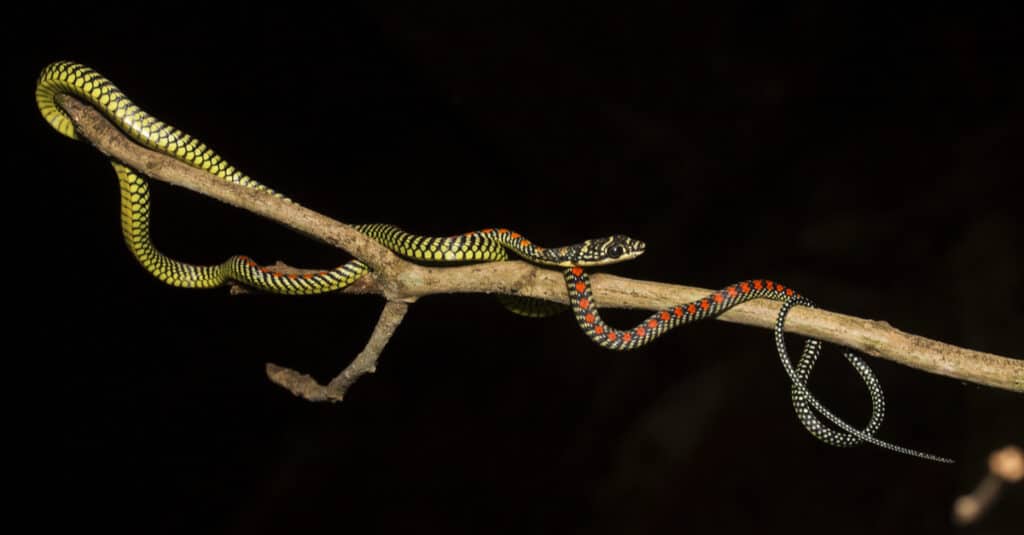
Many flying tree snakes have intricate red and yellow patterns.
©Vince Adam/Shutterstock.com
Why Do Snakes Fly?
By flying or gliding from tree to tree, a flying snake can conserve the energy it would otherwise use climbing up and down trees and across the forest floor while it hunts for prey. In addition, flying snakes can avoid many of the predators that live on the ground.
Check Out Our Video on YouTube:
How Do Snakes Fly?
Despite their name, “flying snakes” do not actually fly, at least not in a traditional manner. Instead, these snakes jump from trees and fall gracefully through the air, stylistically gliding down to their destination. The backs of these snakes are smooth and glossy, but the scales on their bellies are ridged. Flying snakes climb vertically up trees by pressing and moving these texturized belly scales against the tree bark.
When a flying snake wants to jump to a new location, it will move out onto an extended branch and dangle its body down, holding onto the tree with only the end of its tail. As the snake hangs from the tree, it will form its body into a “J”-type shape and lean forward. The snake then throws its entire body out and away from the tree, catapulting into the air. As it soars through the air, the snake sucks in its stomach and flattens its body, forming itself into a concave disc-like shape. Like a flying disc or frisbee, this concave, flattened shape creates air pressure under the snake’s body and propels it along, allowing the snake to fly or glide across long distances.
While in the air, flying snakes also twist their bodies back and forth in an undulating motion. This helps the snake to stabilize its direction while still in the air and control its landing. As strange as it may look, this undulating motion actually increases the snake’s gliding ability and aerodynamics, making it look as if it were effortlessly swimming through the sky. Using this unique technique, a flying snake can glide as far as 330 feet and as fast as 26-33 feet per second through the air!

Flying snakes use an undulating motion to stabilize themselves in the air.
©Somporn Pramong/Shutterstock.com
Where Do Flying Snakes Live?
Chrysopelea, more commonly known as the flying snake or gliding snake, is a genus that belongs to the family Colubridae. Their range is in Sri Lanka, south China, India, southeastern Asia, and the Greater and Lesser Sunda Islands. Flying snakes are a species of arboreal snakes found predominantly in Southeast Asia.
They inhabit trees, living among the branches and leaves, where they hunt for lizards, frogs, and other small animals as their prey. The flying snake is an excellent climber due to its strong prehensile tails, which can be used to grip tree trunks or branches. They also have specially adapted ribs that allow them to flatten their bodies into a flattened diamond shape when gliding through the air from one tree to another. This enables them to glide distances up to 164 feet!
What Is the Largest Flying Snake in the World?
The largest flying snake in the world is the golden tree snake (or ornate flying snake), which can grow up to 4 feet in length! This snake has a thicker body than the other species of flying snakes, weakening its gliding ability. A golden tree snake certainly can still glide from tree to tree, but not nearly as well as many of the other smaller flying snakes.
There are two main color patterns of the golden tree snake. The first, primarily found in southern India and Sri Lanka, has a pale green or a greenish-yellow colored body. Each of its green scales have a small black mark, and many have black outlines around the scale. The snake’s head is black with solid and broken yellow crossbars. Snakes in Sri Lanka sometimes have orange or reddish blotches along the middle of their backs as well, shaped like flowers. Golden tree snakes in Southeast Asia, on the other hand, do not have these spots. These snakes are often more of a bright green color with duller crossband patterns.
Most of the golden tree snakes in the wild live in the western ghats and eastern ghats of India, but some also live in Vietnam, Myanmar, Indonesia, Sri Lanka, and Thailand. Golden tree snakes often live in secondary or re-grown forests, although many have adapted quite well to more developed areas like rural gardens and plantations. Reports suggest that in southern Thailand golden tree snakes often live inside bungalows, hiding in the thatched roofing. They can scale the vertical walls with ease, and commonly hunt mice and geckos in and around the bungalow structures. The golden tree snake’s favorite food is the Tokay Gecko, but they also eat lizards, frogs, rodents, birds, and bats.

The biggest flying snake is the golden tree snake, which is thicker than species such as the paradise flying snake, above.
©reptiles4all/Shutterstock.com
How Big Are Other Flying Snakes?
There are five different species of flying snakes:
- Golden tree snake
- Moluccan flying snake
- Paradise tree snake
- Sri Lankan flying snake
- Banded flying snake.
While the golden tree snake is the largest flying snake, the Moluccan flying snake is not far behind. This snake can grow up to 47 inches long! The Moluccan flying snake lives on Indonesia’s Sulawesi and Ambon islands. Unfortunately, we do not know a lot about it yet.
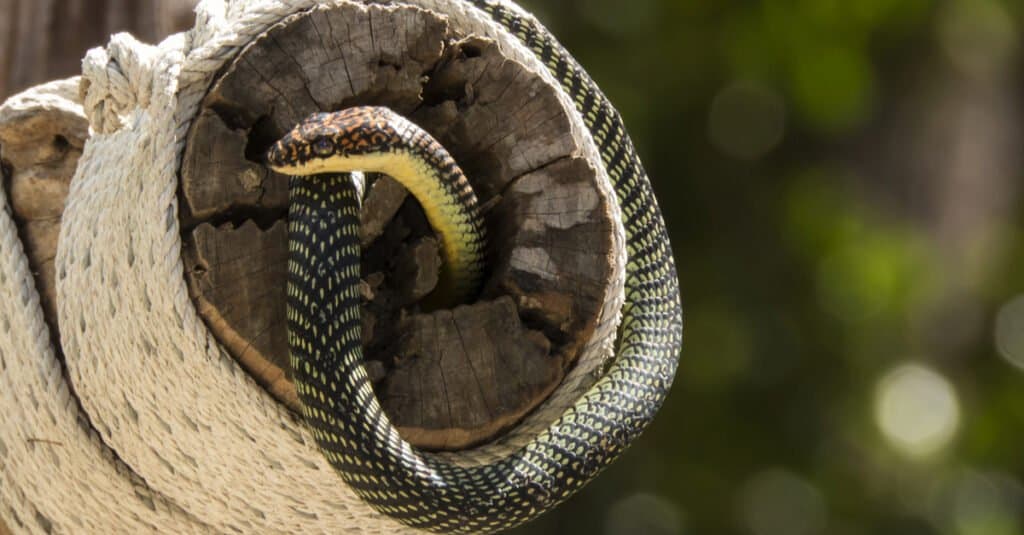
The paradise tree snake is one of five types of flying snakes.
©PACO COMO/Shutterstock.com
The paradise tree snake grows up to 3 feet in length. These snakes are popular in the European pet trade. However, they are the rarest flying snake in the wild, living in Singapore, Thailand, Indonesia, and Cambodia. This snake is typically yellow and black, and many snakes will have additional bright red markings. The paradise tree snake is the best glider of all five flying tree snake species.
The Sri Lankan flying snake is another snake that we know little about. These snakes live in India and Sri Lanka and grow 24-35 inches in length.
Last but certainly not least is the smallest flying snake, the banded flying snake (or twin-barred tree snake). This small snake only grows up to 2 feet in length, half the size of the largest flying snake in the world. The banded flying snake has a reddish or dark gray body, with white or yellow, black, and red, stripes. The sides of the snake’s body are light brown or grey with white spots, and its belly is white and yellow. Although the colors and patterns of the banded flying snake are easy to recognize, this snake is rarely seen. In fact, it is the rarest species of flying snake, living in the humid forests of Singapore, Malaysia, and Indonesia.
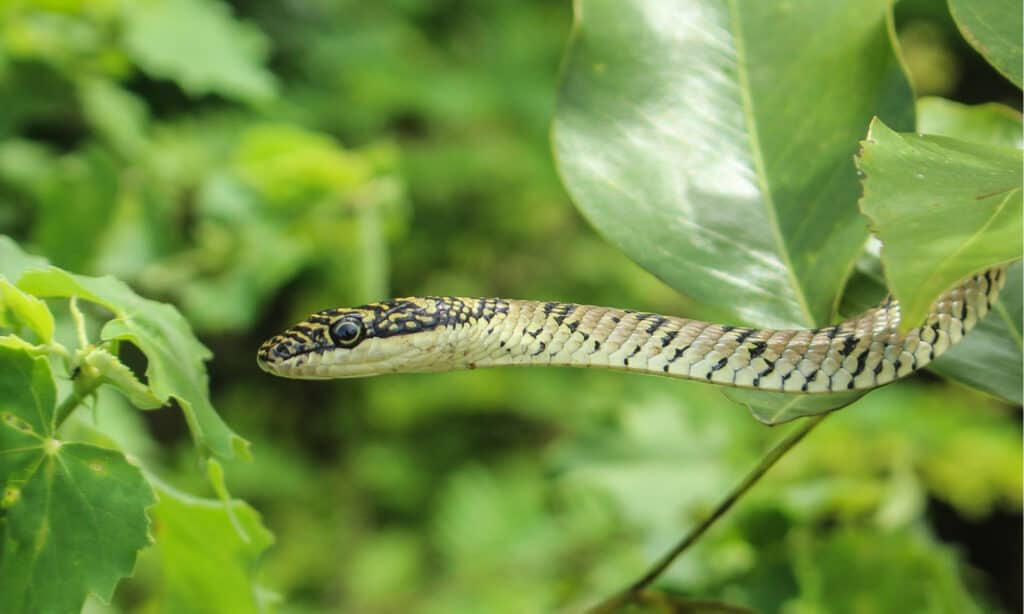
Not much is known about Sri Lankan flying snakes but we do know they can be found in India and Sri Lanka.
©Saranga Athukorala/Shutterstock.com
Flying Snakes as Pets
Because of their unique abilities and bright colors, flying snakes are becoming more popular for reptile collectors. Although their venom is not strong enough to harm humans, these snakes are extremely nervous and bite quickly when touched or picked up. Flying tree snakes do not breed well in captivity due to their anxious nature and often die quickly from stress. In addition, snakes caught in the wild often bring along many parasites when transferred to captivity.
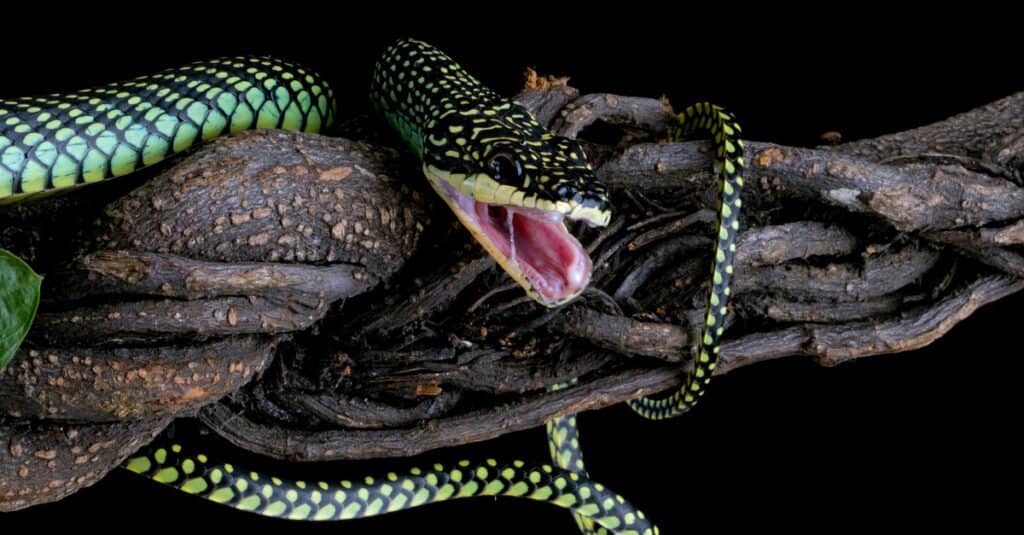
As the flying snake’s venom is not harmful to humans it is possible to keep one in captivity.
©Kurit afshen/Shutterstock.com
Flying Snake Robots
Human technology often builds off many well-constructed plans already found in nature. A great example of this is the design of Snake Robots, which are patterned from the anatomy and movements of various species of snakes, including the flying snake. Snake robots are particularly useful in disaster relief and rescue missions. Some snake robots may even operate in the medical field someday, in place of procedures like colonoscopies. Many scientists are continually studying the anatomy and gliding techniques of flying snakes with the hope that this knowledge can add to further advancement of these serpentine robots and their abilities.
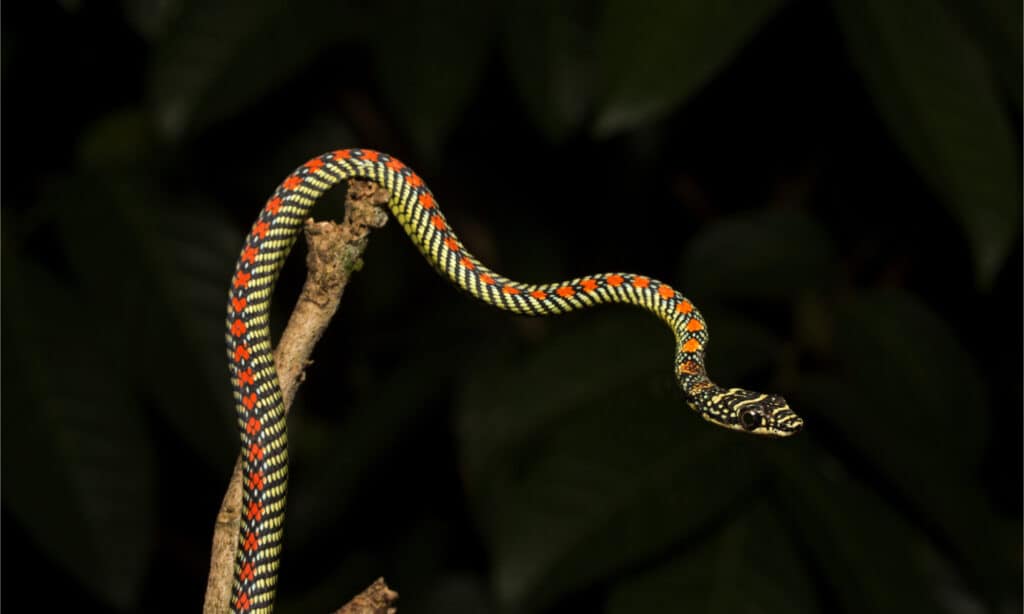
Snake robots are patterned from the anatomy and movements of snakes including flying snake species.
©Vince Adam/Shutterstock.com
The photo featured at the top of this post is © Kurit afshen/Shutterstock.com
Discover the "Monster" Snake 5X Bigger than an Anaconda
Every day A-Z Animals sends out some of the most incredible facts in the world from our free newsletter. Want to discover the 10 most beautiful snakes in the world, a "snake island" where you're never more than 3 feet from danger, or a "monster" snake 5X larger than an anaconda? Then sign up right now and you'll start receiving our daily newsletter absolutely free.
Thank you for reading! Have some feedback for us? Contact the AZ Animals editorial team.







